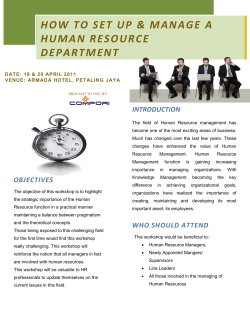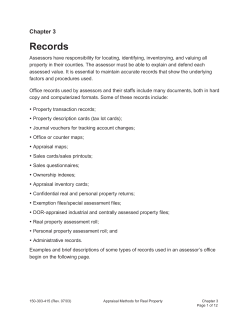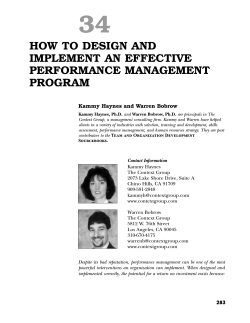
CMMI How To Help Prevent Medicaid IT Disasters 1
CMMI How To Help Prevent Medicaid IT Disasters 1 To err is human but to really foul things up requires a computer. Anonymous 2 2 Grace Hopper Hopper’s s Bug 3 3 Less Benign Impact of Today’s MMIS System S Failure F il 4 4 Overall IT Industry Project Failures • Meta Group p ((2001)) – 55 to 75% of CRM p projects j fail • InfoWorld (2001) - 3 out of 10 projects fail • Avanade (2007) – 40% of business experienced IT project failures between 2004-2006 • KPMG ((2005)) - nearlyy half of surveyy respondents report at least 1 project failure in past year • Standish Group Chaos Report (2006) – 34% of projects completed on time, on budget & specified functionality; up from 16% in 1994! 5 5 Those in Government IT Should Not Th Throw St Stones in i Glass Gl Houses H • North American Computer p Audit,, Control & Securityy Association (2008) – More than 40% of responding government agencies recently “killed” an IT project prior to implementation • Medicaid S System stem Fail Failures res – – – – – Cancelled MMIS projects Major cost overruns Multi-year Multi year schedule slippage Inability to perform key functions correctly Throw-away systems that need to be replaced when proprietary technology becomes obsolescent – Expensive to maintain and operate 6 6 Top 10 Indicators of Failed Projects (S di h G (Standish Group)) 1. 1 2. 3. 4. 5. 6. 7. 8 8. 9. 10. Incomplete requirements Lack of user involvement Lack of resources Unrealistic expectations Lack of executive support Changing requirements & specifications Lack of planning Didn’tt need it any longer Didn Lack of IT management Technical illiteracy 7 7 Top 5 Factors in Successful P j Projects (S (Standish di h G Group)) 1. 1 2. 3. 4. 5. User involvement Executive management support Clear requirements Proper p p planning g Realistic expectations 8 8 Lessons • Most failing projects don’t fail because of t h l technology • Most fail because of problems with the human side id off th the equation: ti – – – – – – Defining goals Defining requirements Project management Co Communication u cat o Managing expectations Management support 9 9 So how do we maximize our chances for success/minimize / i i i probability b bilit off ffailure? il ? • Implement standards and processes that address the core business and g deficiencies identified over management the years: – Requirements development and management – Systems design and development – Systems integration – Risk management – Performance measurement and analysis 10 10 Capability Maturity Model I Integration i (CMMI) • An IT q quality y assurance methodology gy focused on process improvement that was developed by the Carnegie Mellon Software Engineering Institute (SEI) • Originally developed in 1987 and currently incarnated as CMMI Version 1.2 in 2006 in two “constellations” – CMMI for Development (developing products and services) – CMMI for Acquisition (acquiring products and services) • New CMMI for Services under development • Qualifying organizations provide demonstrable adherence dh tto iinternationally t ti ll recognized i db bestt practices ti iin IT project management and development standards 11 11 Benefits of CMMI-DEV CMMI DEV • Better q quality, y costs and schedule adherence in software development • Helps evaluate your potential IT contractors if you are a purchaser of such services • Improves marketing and business development opportunities if you are a contractor: – Recommended by GAO for federal contractors on “high risk” projects – Required by DOD for many IT projects • Level 2 minimum • Level 3 preferred – Required by SBA for IT projects over certain size 12 12 Benefits of CMMI-DEV CMMI DEV • SEI developed 7 measures that are measured in CMMI organizations i ti – Process adherence • “Significant,” “major,” and “improved” adherence to quality engineering standards (multiple companies) – Cost • • • • Median improvement of 34% per SEI 20% reduction in per unit software costs (Lockheed Martin) 33% reduction in costs to fix defects (Boeing Australia) Increased accuracy in cost estimation (Raytheon) – Schedule • • • • Median improvement of 50% per SEI 50% reduction in release turn around time (Boeing Australia) Increased % of milestones met from 50% to 95% (GM) Reduced schedule variance by over 20% (undisclosed company) 13 13 Benefits of CMMI-DEV CMMI DEV • SEI developed p 7 measures that are measured in CMMI organizations – Productivity gains • • • • 61% median di iimprovementt per SEI 30% increase in software productivity (Lockheed) 25% productivity increase (Siemens India) S Significantly f improved productivity (Harris ( Corp.) C ) – Quality • • • • 48% median improvement per SEI Reduced defects per millions over 50% (Lockheed) Met defect goals (Northrup Grumman) Substantial reduction in code defects ((Harris Corp.) p) 14 14 Benefits of CMMI-DEV CMMI DEV • SEI developed p 7 measures that are measured in CMMI organizations – Customer satisfaction • 14% median improvement per SEI • Improved average customer satisfaction rating by 10% (Siemens India) • Increased performance award fees by 55% (Lockheed Martin) • Earned E d “E “Exceptional” ti l” rating ti iin every category t b by customer t (Northrup Grumman) – ROI • • • • 4:1 median improvement per SEI 2:1 ROI (Siemens India) 5:1 ROI (Accenture) p Grumman)) 13:1 ROI ((Northrup 15 15 Who Gets CMMI Appraised? • Public sector organizations g and companies p in many y industries – Arizona AHCCCS IT, only known Medicaid IT organization with CMMI (Level 2) – Others in Medicaid industry include Accenture, ACS (older CMM standard) Dyncorp, EDS, IBM, Infosys, KPMG, Lockheed, Northrup, SAIC, Tata, TRW, and Wipro (but may not apply to all civilian federal federal, state state, and local lines of business) • Organizations and companies in 61 countries • How appraisals since many to date? – 1581 appraisals 2002 - 2006 – 1377 organizations 2002 - 2006 16 16 Not very many! 17 17 18 18 Climbing the CMMI Maturity Model 19 19 CMMI Maturity Model • 5 levels of increasing maturity –L Levell 1 1: P Performed f d (lik (like MITA L Levell 1 – everyone does it, but not well, not repeated, and not institutionalized) – Level 2: Managed (basic infrastructure in place to support the process) – Level 3: Defined (organization-wide standards, process descriptions, descriptions and procedures exist) – Level 4: Quantitatively managed (processes are controlled using statistical and other quantitative techniques) – Level 5: Optimizing (Improving Level 4 processes based on an understanding of the common causes of variation inherent in the process) 20 20 21 21 CMMI Approaches • Two ways to get appraised for Level 2 or above: – Staged – most common • Based on achieving desired level of maturity model for the applicable 22 Process Areas – Continuous C ti – less l common, especially i ll ffor new appraisals • Based on achieving desired capability level for desired four major process area categories 22 22 CMMI-DEV CMMI DEV Framework Organizational g Processes Process Area 1 Goals 1 - 4 Process Areas 2 - 22 2 Practice P ti Practices 2 2-N N 23 23 Staged Appraisal Required Practices b M by Maturity t it Level L l Maturity Model Level Number of Practices Cumulative Practices 1 0 0 2 7 7 3 11 18 4 2 20 5 2 22 24 24 Process Areas by Maturity Level Abbreviation Name REQM PMC Requirements Management Project Monitoring and Control PP Project Planning SAM Supplier Agreement Management CM MA PPQA PI RD TS VAL VER OPD Configuration Management Measurement and Analysis Process and Product Quality Assurance Product Integration Requirements Development Technical Solution Validation Verification Organizational Process Definition OPF Organizational Process Focus OT Organizational Training IPM Integrated g Project j Management g RSKM Risk Management DAR OPP Decision Analysis and Resolution Organizational Process Performance QPM Quantitative Project Management OID Organizational Innovation and Deployment CAR Causal Analysis and Resolution Process Area Engineering Project Management Project Management Project Management Support Support Support Engineering Engineering Engineering Engineering Engineering Process M Management t Process Management Process Management Project j Management Project Management Support Process Management Project Management Process Management Support Maturity Level 2 2 2 2 2 2 2 3 3 3 3 3 3 3 3 3 3 3 4 4 5 5 25 25 Practices by Goal (Example: Project Planning Process Area) Abbreviation SG1 SP1.1 SP1.2 SP1.3 SP1.4 SG2 SP2.1 SP2 2 SP2.2 SP2.3 SP2.4 SP2.5 SP2 6 SP2.6 SP2.7 SG3 SP3.1 SP3 2 SP3.2 SP3.3 Project Planning Goals Establish Estimates Project Planning Practices Estimate Scope of the Project Establish Estimates of Work Product and Task Attributes Define Project Lifecycle Determine Estimates of Effort & Cost Develop a Project Plan Establish the Budget and Schedule Identify Project Risks Plan for Data Management Plan for Project Resources Plan for Needed Knowledge & Skills Plan Stakeholder Involvement Establish the Project Plan Obtain Commitment to Plan Review Plans that Affect the Project Reconcile Work & Resource Levels Obtain Plan Commitment 26 26 Standard CMMI Appraisal Method for Process Improvement (SCAMPI) • Method byy which CMMI maturity y is assessed • Must be performed by an SEI-approved independent appraiser who compares documented compliance against the CMMI standards • Requires two or more relevant projects • Assessment is good for three years • Three types of assessment: – SCAMPI A: only one with official rating – SCAMPI B: – SCAMPI C: 27 27 SCAMPI Appraisal Classes Requirements Types of Objective Evidence Gathered Class A Class B Class C Documents and interviews Documents and interviews Documents or interviews Not allowed Not allowed Organizational Unit Coverage Goal ratings required Required Not required Not required Minimum Team Size 4 2 1 Appraisal Team Leader Requirements Lead appraiser Person trained and experienced Person trained and experienced Ratings Generated 28 28 SCAMPI Appraisal Process • SCAMPI appraisal process consists of: – Preparation – On-site On site activities – Preliminary observations – Findings – Ratings – Final Fi l reporting ti – Follow-on activities 29 29 What Does It Take? • Time – 6 to 12 months for most organizations to obtain Level 2 appraisal • Moneyy – “5 to 6 figures” g depending p g on scope p of the appraisal and size and complexity of the organization • Commitment – Executive management – Middle management – PMs, developers, analysts, and all other team members 30 30 What Can’t Can t CMMI Do? Dr. Rick Hefner, a leading CMMI appraiser, states that “a CMMI appraisal indicates the organization’s capacity to perform the next project, but cannot guarantee that each new project will perform in that way.” 31 31 What Can You Do? • Adopt p CMMI-DEV standards and obtain SCAMPI Level 2 or higher appraisal • If you cannot be CMMI appraised, incorporate internally as much as possible, e.g., ANSI 748-a 748 a Earned Value Management • Require your IT vendors to either have or achieve Level 2 by start of project and Level 3 by end of project project. Could provide additional evaluation points for Levels 4 and 5. • Evaluate CMMI Services when finalized to see if appropriate i t for f Fiscal Fi l Agent A t business b i operations ti • Could consider alternative QA methodologies such as ISO 32 32 Earned Value Management (EVM) • Earned Value (EV) is calculated by adding up the budgeted cost of every activity that p using g Actual Cost has been completed and Planned Value (Cost) to estimate: – Schedule Variance (ahead or behind schedule)) – Cost Variance (ahead or behind on budget) – Schedule S h d l P Performance f IIndex d ((run rate t on schedule) – Cost Performance Index (burn rate on budget) 33 33 How Do You Start? • Learn more about CMMI at http://www.sei.cmu.edu/cmmi/ • If you decide to start start, hire a competent competent, SEI-certified CMMI consultant and appraiser 34 34 35 35
© Copyright 2025
















